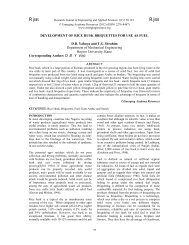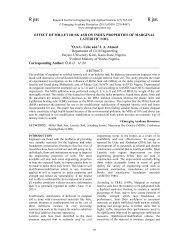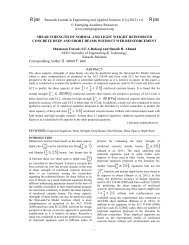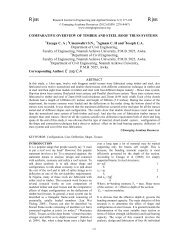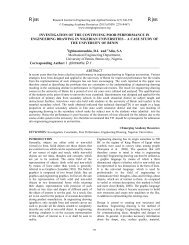Download full paper - RJEAS - Emerging Academy Resources
Download full paper - RJEAS - Emerging Academy Resources
Download full paper - RJEAS - Emerging Academy Resources
You also want an ePaper? Increase the reach of your titles
YUMPU automatically turns print PDFs into web optimized ePapers that Google loves.
Rjeas Research Journal in Engineering and Applied Sciences 1(6) 413-418 Rjeas© <strong>Emerging</strong> <strong>Academy</strong> <strong>Resources</strong> (2012) (ISSN: 2276-8467)www.emergingresource.orgBLOCK-STRUCTURED PETROLEUM TANKER-ROUTING MODEL FOR THEDISTRIBUTION OF PETROLEUM PRODUCTS1 H.I. Ojarikre and 2 P.O. Ekoko1 Department of Mathematics and Computer Science,Delta State University, Abraka, Delta State.2 Department of Mathematics,University of Benin, Benin-City, Edo State.Corresponding Author: H.I. Ojarikre___________________________________________________________________________ABSTRACTThe distribution of refined petroleum products is a fundamental problem that is central to the downstream sectorof the oil refinery industry. We propose a block-structured Linear Programming (LP) tanker-routing model forthe distribution of petroleum products that determines the loading and discharge times at refineries and depotsrespectively in such a way that the total number of petroleum tankers is kept minimum. The model considers theminimization of the total transportation cost by maximizing the possible number of reassignments of availablepetroleum tankers subject to the loading and discharge constraints. The work focuses on block-structured LPmodels where the subproblems comprises the independent and common constraints. By this study, to thepetroleum marketers the total cost of distributing the petroleum products can be drastically reduced. In addition,wrong distribution procedures resulting in product scarcity can be avoided. Hence, this work will helpresearchers in petroleum industries and the society at large to know that the trivial solution usually obtainedwhen solving Block-Structured LP problems can be overcome by incorporating the common constraints into theindependent constraints.©<strong>Emerging</strong> <strong>Academy</strong> <strong>Resources</strong>KEYWORDS: LP models, block-structure, petroleum tankers, oil refinery problems, number of reassignments.________________________________________________________________________________________INTRODUCTIONThe distribution of refined petroleum products is afundamental problem that central is to the oil refineryindustry. The refinery problems can be classified intothree broad categories as shown in Fig. 1. The kindsof problems associated with each category arespecified as follows:different from the general transportation problem(TP). Transportation cost constitutes a major part ofthe entire production cost. In Nigeria, we oftenexperience scarcity of some of the petroleumproducts. This is as a result of wrong distributionmethod or the refineries producing below theirinstalled capacity or as a result of break down of the(i) Exploration, crude oil production and refineries or the obsolete facilities which are notransportation of crude oil to terminal or refinery. longer in use.(ii) Crude selection, refining and reforming of crudeto meet product specification and at the same timemaximize total income.(iii) The distribution of the refined products fromrefineries to depots through pipelines or throughpetroleum tankers to various filling stations.The three categories can be further summarized intotwo major groups, namely; the upstream anddownstream sectors. Category (i) is upstream sectorproblem while categories (ii) and (iii) aredownstream sector problems. This <strong>paper</strong> is centred oncategory (iii) which is an aspect of the downstreamsector. Our work is how best to plan the distributionof the refined products to the final consumers. Theproblem of distribution of the petroleum productsfrom refineries to depots and sales outlets isformulated as a transportation model which isThe Nigerian populace consume about 33 millionlitres of PMS daily but within the country, therefineries produce about 17 million litres per day andthe remaining 16 million litres is imported into thecountry. The distribution of some of these products isthrough the use of petroleum tankers from the portsto the various filling stations.The problem of inadequate number of tankers for thedistribution of petroleum products has in recent yearsbecome more crucial than ever before in Nigeria.Sasikumar et al., (1997) stated that transportation ofpetroleum products through pipelines is the mostreliable and economical mode. But in Nigeria therehas been many instances of pipeline vandalism whichoften results in huge financial loss to the nation, lossof capital investment on oil installation and also loss413
Research Journal in Engineering and Applied Sciences (ISSN: 2276-8467) 1(6):413-418Block-Structured Petroleum Tanker-Routing Model for the Distribution of Petroleum ProductsTransportation Model Approach of Tanker-Routing ModelThe constraintsx A , i couples,A 0jj ijx ijx i j iBj 0 i, jcouples,B 0represent a transportation problem formulation whereA denotes the supply limits while B representsithe demand requirements. Introduction of slackvariables Q iand Rjinto the first twoconstraints above yield the general transportationmodel (TM). That is, j iQjjxij Qj Ai , i and Ai 0 (5)x ij Rj Bj, jand Bj 0 (6)andR ijrepresent the number of tankersoriginating from i at time and the number oftankers terminating at j at time respectivelyThus from (5), we haveQ i z Ai(7) iiand from (6), we haveR j z Bj(8)wherez j i i jxj ij andA i Bj(9) jThis is based on the assumption that there are noaccidents and other disasters along the way.The objective function is to minimize the totalnumber of tankers in use which is equivalent tomaximizing z. However,Q and R respectively represent the number i jof tankers originating fromterminating atQi Rj i jLDiat time andLP at time . Thus, we have thatj total number of tankers.Therefore, put together, the equivalent TP isMaximize z x ij(10) i jSubject tox ij Qi Ai, icouples , Ai0(11) jix i j Rj Bj , j couples,Bj 0(12)x i j 0(13) i , j and for effective travellingtime from j to iThe nonnegativity constraints in (13) refer to possibleor impossible reassignments.The downstream petroleum tanker-routing problem inequations (10) – (13) has block-structured formatwith common constraints as in Fig. 2. Like the caseof the balanced TP, the row constraints are the sets ofindependent block constraints (i.e. equations (11))while the column constraints (equations (12))constitute the common constraints.C TOptimize Z =Subject toActivity 1xVariables in activity 1, activity 2,…, activity n are ≥0Fig. 2. Block-structured format of the tankerroutingmodel with independent andcommon constraintsThe steps for obtaining the block-structured LP inequations (10) – (13) are contained in the followingalgorithm.Algorithm for the Tanker-Routing ProblemThe aim is to maximize total number ofreassignments thereby reducing the total number oftankers needed. To achieve this, we follow the stepsbelow.Step 1: Set tables for loading time of products ateach loading depot LD to be dischargediat discharge point DP j and maximumtraveling times (days) of a tanker fromLD to for the period.iDP jStep 2: Compute the table of discharge times ofproducts at DP for the period. That is, addjthe corresponding entries of Tables 1 and 2to get Table 3.Step 3: At a particular LDi , from the set of dates,determine the earliest possible dates thatloading can take place to be discharged atDP .jActivity 2Common ConstraintsActivity nIndependentconstraints416
Research Journal in Engineering and Applied Sciences (ISSN: 2276-8467) 1(6):413-418Block-Structured Petroleum Tanker-Routing Model for the Distribution of Petroleum ProductsStep 4: If effective traveling time fromj to i , then 0xi jx . Otherwise, i jexists if effective traveling timefrom j to i . That is, 0 . The sumof all thexi jx i j is the objective function i.e.Max z ijx ijFor the constraints formulations, there aretwo sets of constraints; row and columnconstraints.Step 5: Two additional tables are drawn upspecifying the number of times a particulardate appears in a period at LD and atDPjrespectively. Ifxi iexists, then allthe reassignments for that date at LDicannot be greater than the number of tankersloading at i . Similarly, all the reassignmentscannot be more than the number of tankersdischarging at jStep 6: If there are no more loading dates toconsider, then a tanker has come to the endof its run for the period, then stop.Step 7: If there are more unused dates at LDiafterthe initial assignment, go to step 5. Assignmore tankers until all the dates have beenused, then stop.LP problems. The corresponding block structuredformat of our model is given below.CONCLUSIONBlock-structured LP models are linear constrainedoptimization problems where each block comprisesdifferent subproblems of the same refinery. Thedistribution of petroleum products from refineries todepots and filling stations can be carried out throughpipelines, vessels, road by petroleum tankers andthrough railways. The pipeline model oftransportation is better and more economical but thisadvantage cannot be realized in our environment dueto pipeline vandalism . This shows that pipelinedistribution of petroleum products has numeroushazards when used in our environment. Hence wedeveloped a unique model that can correct thesedisadvantages by making optimal use of the availablepetroleum tankers.Moreover, the cost of acquiring these petroleumtankers is very high, thus the problem of inadequatenumber of tankers for the distribution of petroleumproducts. Therefore our tanker-routing modeldeveloped can reduce cost of transportation bymaximizing the total number of reassignments of theavailable tankers. By the use of the tanker-routingmodel it is possible to know the minimum number oftankers needed and how many of them should beireassigned from Discharge Points DP j to LoadingDepots LD for loading. Consequently, optimaliactivity dates atDP and LD can be determinedjand proper planning made ahead to take care of anyenvisaged failure.REFERENCESBodin, L., Golden, B., Assard, A. and Ball, M.(1983), “Routing and Scheduling of Vehicles andcrews: the state of the Arts”. Computers andOperations Research 10(2), pp. 62-71.Escudero, R. F., Quintana, F. J. and Salmeron, J(1999), “CORO, a Modeling and an AlgorithmicFrame Work for Oil Supply, Transaction andDistribution Optimization” Eur. J. Operation,Research 114 (3) pp. 638-656.Hitchcock, F. L. (1941), “The Distribution of aProduct from Several Sources to NumerousLocalities,” J. Mathematical Physics, 20, pp. 224-230.Iakovou, E. T. (2001), “An Interactive MultiobjectiveModel for the Strategic Transportation of PetroleumProducts: Risk analysis and Routing”, Safety Science,39, pp. 19-29.Jones, W. M. C. and Paddock, K. F. (1982),“Transport by Pipelines” in G. D. Hobson Edition,Morden Petroleum Technology, 5th edition Part 1Wiley, England.Lee, H., Pinto, J. M., Grossmann, I. E. and Park, S.(1996), “Mixed Integer Linear Programming Modelfor Refinery Short-Term Scheduling of Crude OilUnloading with Inventory Management”. Industrialand Engineering Chemistry Research, 35, PP. 1630-1641.Li, J., Li, W. Karimi, I. A. and Srinivasan, R. (2007),“Imroving the Robustness and Efficiency of CrudeScheduling Algorithms” AICHE Journal 53, pp.2659-2680.Magatao, L., Arruda, L. V. R. and Neves-Jr, F.(2002), “A mixed Integer Programming Approach forScheduling Commodities in a Pipeline”. ESCAPE 12Proceedings the Hague (NL), pp. 715-720.Moro, I. F. L. and Pinto, J. M. (2004), “Mixed IntegerProgramming Approach for Short-Term Crude OilScheduling”, Industrial and Engineering ChemistryResearch 43, pp. 85-94.Pirkul, H. and Jayaran, V. (1998), “A Multi-Commodity, Multi-Plant Capacitated FacilityLocation Problem: Formulation and EfficientHeuristic Solution”, Computers Operations Research25 (10), pp. 869-889.i417
Research Journal in Engineering and Applied Sciences (ISSN: 2276-8467) 1(6):413-418Block-Structured Petroleum Tanker-Routing Model for the Distribution of Petroleum ProductsReddy, P. C. P., Karimi, I. A. and Srinvasan, R.(2004a), “A Novel Solution Approach for OptimizingCrude Oil Operations”. AICHE Journal 50 (6), pp.1177-1197.Reddy, P. C. P., Karimi, I. A. and Srinivasan, R.(2004b), “A new Continuous Time Formulation forScheduling Crude Oil Operations”, ChemicalEngineering Science 59, pp. 1325-1341.Rejowski, R., Jr., and Pinto, J. M. (2003),“Scheduling of a Multiproduct Pipeline System”,ELSEVIER Computers and Chemical Engineering,27, pp. 1229-1246.Ross, A. D. (2000), “Performance-Based StrategicResource Allocation in Supply Networks”International Journal of Economics 63, pp. 255-266.Russel, R. S. and Taylor, B. W. K. (1998),“Operations Management Focusing on Quality andCompositeness”. Prentice Hall of Austrial Ltd,Sydney.Sasikumar, M. Prakash, P. R., Patil, S. M. andRamanis. (1997), “Pipes: A heuristic Search Modelfor Pipeline Scheduling Generation”, KnowledgeBased System 10, pp. 169-179.Sear, T. N. (1993), “Logistic Planning in theDownstream” J. Operations Research Society, Vol.44 (1), pp. 9-17.Tahmassebi, T. (1998), “An Aproach to Managementof Multilevel Distribution Systems for ConsumerGoods and Chemical Industry Under InformationUncertainty”. Computers and Chemical Engineering22, pp. 52-63.Trierwiler, D. and Tan, R. L. (2001), “Advances inCrude Oil LP Modeling”. Hydrocabon Asia,November/December, 11(8), pp. 52-58.APPENDIXBoundary of category (i) problem(Upstream sector)Boundary of the category (ii) problem(Downstream Sector)Crude oil from oilfields (Upstream Sector)RefineryAlkylateCatalytic reforming gasolineStraight-run gasolineFluid cat. Cracked gasolineRefinery x( A)1( A)x2( A)x3( A)x4( B)x1( B)x2( B)x3( B)x4( C)x1( C)x2( C )x3( C )x4( D)x1( D)x2( D)x3( D)x4LPG(A)PMS(B)Kero(C)Diesel(D)To consumerTo consumerTo consumerTo consumerBoundary of category (iii) problem (Downstream Sector)Other streamsNaphthaRefineryOther streamsTo consumerFig. 1 Showing Interdependent Activities that go on in a Refinery.418



